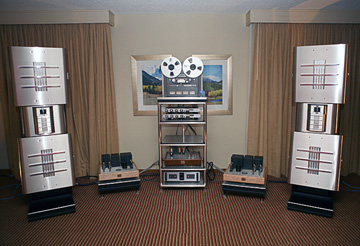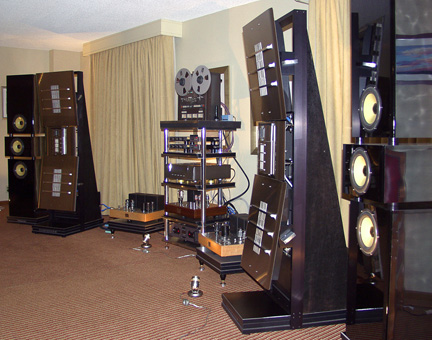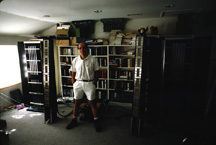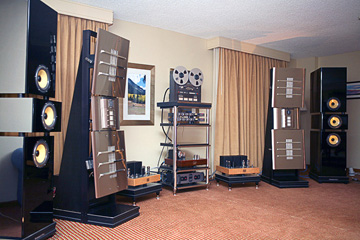Introduction
The Panorama is the result of decades of development of a true state-of-the-art ribbon / planar magnetic / dynamic hybrid speaker system, and features new techniques of diaphragm design and suspension. Combined with no-compromise frame and magnet motor construction which benefits from well-known Symposium isolation, damping, and mechanical grounding technology. The Panorama achieves effortless transparency, speed and fidelity to the input signal, with room-filling image width, height and depth on appropriately recorded stereophonic recordings, yet will not "bloat" or exaggerate the size of sonic images. Its outboard passive crossover system employs low-distortion, phase-correct slope filters in order to preserve transient response across the audible range; each driver has been carefully designed, sized and positioned in order to preserve these proper imaging and virtual size characteristics.
The first public demonstration of Panorama technology was made in 1994 in Los Angeles with a bi-amplified, line-source system which included a full-range ribbon-drive HF line source section and a separately powered, planar "ribbon bass" driver (see photo at bottom of page). The prototypes displayed at the 2006 and 2007 Rocky Mountain Audio Fest and at CES 2007 have now been replaced with a full production version that employs newly designed lower midrange, upper midrange high frequency planar drivers, and true ribbon dipolar tweeters combined with a unique triple-enclosure bass system that consists of both transmission line and sealed enclosures loaded with matching state of the art, low mass cone drivers.
Description
 The Panorama is a five-way hybrid loudspeaker system consisting of proprietary ribbon. planar magnetic and state of the art cone drivers. Response is smooth over the range of human hearing and the entire speaker can be driven with only one amplifier through the Panorama's passive, adjustable crossover network- the bass towers are not separately powered or biamped. Amplifiers of only 20 watts power or less (efficiency is approximately 92 dB) are all that is needed to drive the speaker to satisfying levels with most music; 60 watts per channel is plenty of power to give satisfying room-filling sound with powerful bass. In addition, the Panorama's impedance load never dips below about 4 ohms, and maintains a nominal 8 ohm or higher load over most of the speaker's range, making the Panorama truly an "amplifier friendly" load. Thus, efficiency, frequency response, transient response and power response (which describes the loudspeaker's ability to evenly distribute all frequencies throughout the entire room, and not just in one directed sector) are outstanding, a result of the Panorama's quasi-point source, mostly dipolar design which preserves a fairly constant ratio of wavelength to driver size from the lower midrange on up. The Panorama's midrange-through-tweeter drivers as well as bass drivers are arranged for optimum dispersion in MTM (midrange-tweeter-midrange) arrays in order to preserve accurate reproduction of the virtual sound source "image." To our knowledge, the Panorama is the first loudspeaker to utilize disparate planar magnetic and ribbon drivers which cover different frequency ranges in an all-planar MTM configuration, and also the first to divide up the bass range into two parts and use a similar MTM arrangement for the bass system. The critical Upper Midrange and Ribbon Tweeter drivers are mounted on a separate baffle which "floats" independently of the main frame Lower Midrange drivers in a proprietary isolation scheme that prevents intermodulating vibration from other driver from coloring the output in the critical upper midrange/tweeter range; the Triple Enclosure Bass system is also individually Rollerblock isolated for lowered distortion. The Panorama benefits not only from unique Symposium driver technology, but also from well-known Symposium vibration control techniques. The culmination of these advances and superior technologies is a loudspeaker which offers exciting, engaging, musically realistic performance that is as unique as it is superlative. While basically similar in design to the original Panorama prototype loudspeakers demonstrated in 2006 and 2007, the current Panorama is a full production model and is every bit as extraordinary as its direct ancestor throughout the midrange, but with markedly superior bass and treble performance and improved coherency. Hence, the current production model is referred to as the Panorama 2.0.
The Panorama is a five-way hybrid loudspeaker system consisting of proprietary ribbon. planar magnetic and state of the art cone drivers. Response is smooth over the range of human hearing and the entire speaker can be driven with only one amplifier through the Panorama's passive, adjustable crossover network- the bass towers are not separately powered or biamped. Amplifiers of only 20 watts power or less (efficiency is approximately 92 dB) are all that is needed to drive the speaker to satisfying levels with most music; 60 watts per channel is plenty of power to give satisfying room-filling sound with powerful bass. In addition, the Panorama's impedance load never dips below about 4 ohms, and maintains a nominal 8 ohm or higher load over most of the speaker's range, making the Panorama truly an "amplifier friendly" load. Thus, efficiency, frequency response, transient response and power response (which describes the loudspeaker's ability to evenly distribute all frequencies throughout the entire room, and not just in one directed sector) are outstanding, a result of the Panorama's quasi-point source, mostly dipolar design which preserves a fairly constant ratio of wavelength to driver size from the lower midrange on up. The Panorama's midrange-through-tweeter drivers as well as bass drivers are arranged for optimum dispersion in MTM (midrange-tweeter-midrange) arrays in order to preserve accurate reproduction of the virtual sound source "image." To our knowledge, the Panorama is the first loudspeaker to utilize disparate planar magnetic and ribbon drivers which cover different frequency ranges in an all-planar MTM configuration, and also the first to divide up the bass range into two parts and use a similar MTM arrangement for the bass system. The critical Upper Midrange and Ribbon Tweeter drivers are mounted on a separate baffle which "floats" independently of the main frame Lower Midrange drivers in a proprietary isolation scheme that prevents intermodulating vibration from other driver from coloring the output in the critical upper midrange/tweeter range; the Triple Enclosure Bass system is also individually Rollerblock isolated for lowered distortion. The Panorama benefits not only from unique Symposium driver technology, but also from well-known Symposium vibration control techniques. The culmination of these advances and superior technologies is a loudspeaker which offers exciting, engaging, musically realistic performance that is as unique as it is superlative. While basically similar in design to the original Panorama prototype loudspeakers demonstrated in 2006 and 2007, the current Panorama is a full production model and is every bit as extraordinary as its direct ancestor throughout the midrange, but with markedly superior bass and treble performance and improved coherency. Hence, the current production model is referred to as the Panorama 2.0.
The Planar Drivers
At the heart of the Panorama are its planar magnetic and ribbon drivers, designed and manufactured exclusively by Symposium, which benefit from new, proprietary technologies. The drivers are constructed with no-compromise materials to achieve extreme rigidity and low or zero chassis resonance, and team extremely powerful neodymium iron boron magnet motors with extremely light, specially suspended diaphragms to deliver lightning fast transient response, flat frequency response, realistic imaging, and unparalleled transparency and musicality. The larger lower midrange drivers may each be tilted at precise angles of the owner's choice in order to tailor the directive pattern of the speaker to individual room characteristics and seating. This gives the owner the ability to "dial in" imaging and thus precisely match the Panorama to his or her individual personal preferences for virtual imaging characteristics.
Triple Enclosure Bass System
 The Panorama 2.0's bass system is the first (to our knowledge) that combines the controlled and extended low frequency power of a properly damped transmission line with the nearly perfect transient and smooth frequency response of a low-Q sealed enclosure in the same 20 to 200 Hz bass range. The middle woofer is a sealed enclosure which covers the critical transitional range from 70 Hz to 200 Hz, while the larger, twin transmission line cabinets above and below it (in a bass-only version of the classic "MTM" configuration) do the "heavy lifting" from 70 Hz down to 20 Hz. All three bass cabinets are of extremely robust construction, with front tapered panels of solid, 5/8" thick (0.625" thick) 6061 "aircraft" aluminum. These front panels are one-piece units which are precision machined to directly accept the three identical, very fast Kevlar 8" drivers. This makes the entire front panels an extension of the metal frames of the woofers, at the same time dissipating spurious frame resonances and also stiffening their frames considerably beyond what is possible with conventional wood enclosures. The solid aluminum panels are bolted and bonded to triple-laminated composite sub-wall of typical "Symposium" constrained layer techniques for a total enclosure of outstanding strength, stiffness, and acoustic neutrality. Each woofer tower weighs approximately 550 pounds. In addition, the three bass enclosures are Rollerblock isolated from one another to reduce mutual coupling at low frequencies, reducing intermodulation distortion caused by other drivers. The entire stack is then mounted on a dedicated black-top "Stealth" Ultra Platform for both absorption of spurious, internally generated mechanical energies and as well as isolation from the floor. Even though the entire stack is quite heavy (a desirable characteristic for bass loudspeakers), the Ultra Platform base enables the entire stack to be moved over most surfaces for precise speaker placement. The Panorama's bass system blends seamlessly with the high frequency tower while delivering realistic, authoritative bass which is at once nimble and powerful.
The Panorama 2.0's bass system is the first (to our knowledge) that combines the controlled and extended low frequency power of a properly damped transmission line with the nearly perfect transient and smooth frequency response of a low-Q sealed enclosure in the same 20 to 200 Hz bass range. The middle woofer is a sealed enclosure which covers the critical transitional range from 70 Hz to 200 Hz, while the larger, twin transmission line cabinets above and below it (in a bass-only version of the classic "MTM" configuration) do the "heavy lifting" from 70 Hz down to 20 Hz. All three bass cabinets are of extremely robust construction, with front tapered panels of solid, 5/8" thick (0.625" thick) 6061 "aircraft" aluminum. These front panels are one-piece units which are precision machined to directly accept the three identical, very fast Kevlar 8" drivers. This makes the entire front panels an extension of the metal frames of the woofers, at the same time dissipating spurious frame resonances and also stiffening their frames considerably beyond what is possible with conventional wood enclosures. The solid aluminum panels are bolted and bonded to triple-laminated composite sub-wall of typical "Symposium" constrained layer techniques for a total enclosure of outstanding strength, stiffness, and acoustic neutrality. Each woofer tower weighs approximately 550 pounds. In addition, the three bass enclosures are Rollerblock isolated from one another to reduce mutual coupling at low frequencies, reducing intermodulation distortion caused by other drivers. The entire stack is then mounted on a dedicated black-top "Stealth" Ultra Platform for both absorption of spurious, internally generated mechanical energies and as well as isolation from the floor. Even though the entire stack is quite heavy (a desirable characteristic for bass loudspeakers), the Ultra Platform base enables the entire stack to be moved over most surfaces for precise speaker placement. The Panorama's bass system blends seamlessly with the high frequency tower while delivering realistic, authoritative bass which is at once nimble and powerful.
The Crossover Network
The crossover may be likened to the "brain" of any multi-way loudspeaker system, and orchestrates each element's contribution to the reassemblage of the original signal. Crossover network design is as important as any other aspect of loudspeaker design: it doesn't matter how good the speaker drivers are if the crossover isn't correctly designed. The crossover network is constructed with high quality wire, solid silver buss bar, premium silver/teflon capacitors and high quality resistors. Inductors are exclusively premium 12 gauge copper foil units for the critical midrange and up, while low-resistance, high-permeability core coils are employed for the low frequency filters. All parts, especially the inductors, are critically placed for minimum interaction with one another. The inductors' magnetic fields are experimentally determined and the coils have been oriented for minimum field interaction with one another, a technique which can substantially reduce intermodulation distortion. In addition, all components are measured by laboratory-grade impedance bridge during construction to verify unit-to-unit tolerances with regard to both value and Q while actually in place. The crossover network is built on a special Ultra Platform with no metal, so that the values of the inductors are not skewed. A 4-switch level control provides 5 different levels for 4 of 5 drivers to account for differences in room setup, recording variations, and personal preferences. The switches are of very high quality and employ silver coin-contacts for complete transparency while in circuit.
The Absolute Phase
Nearly every recording has a specific phase orientation - positive or negative - and one or the other orientation will provide audibly better performance. The Panorama crossover network contains a bypassable, built-in DC relay system with triple-redundant silver contacts to give the user the ability to switch absolute phase from the listening position. The Panorama's phase control enables the listener to change phase in an absolutely passive network with zero coloration - something that many phase controls in electronics further upstream may not necessarily provide, in order to provide the ultimate listening experience without compromise.
Driver Compound Isolation and chassis Vibration Control
The Panorama benefits from Symposium isolation and vibration control techniques, with heavy 3" X 1" 6061 solid aircraft aluminum upright and cross support bars. This support system for the ribbon and planar panel drivers simultaneously damp spurious vibration while providing an unimpeded, non-reactive mechanical ground path. The uprights are terminated to a CNC fabricated, dedicated Stealth Edition Ultra Platform base, which simultaneously absorbs spurious energy from the drivers while isolating from floor-borne vibration sources. The HF panel tower's side panels afford additional damping of frame vibrations while shaping rear wave radiation to optimize the Panorama's imaging characteristics. Rollerblock isolation is used under the HF tower to reduce intermodulation distortion, and the upper midrange and tweeter planar drivers are additionally compound-isolated from the main frame of the HF section with a floating, tuned damped spring suspension system. Due to the addition of isolation systems in series (as oppposed to merely in parallel), the extremely critical upper midrange and tweeter units benefit from Compound Isolation, patented by Symposium.
Press Reactions
The Panorama has earned extraordinarily positive reactions and attention from both audiophiles and press alike, including The Absolute Sound. Their RMAF 2007 show report about the original Panorama protoype led to a coveted and unprecedented 2008 Golden Ear Award from senior reviewer Jonathan Valin. Mr. Valin's Golden Ear Award was the first ever awarded to a loudspeaker prototype. In addition, we are very proud to report that the Panorama was awarded Mr. Valin's much coveted "Best Sound at Show" award for the second consecutive year at the Rocky Mountain Audio Fest in 2008.
Pricing and Availability
The Panorama is now in production, available to private individuals or dealers with standard or custom finishes to suit decor and personal preference. For information on pricing, availability, or to make an appointment for a demonstration, please contact Symposium.

The "Symposium," an experimental loudspeaker in a photo taken during its initial demonstration in Los Angeles in 1994. Click on the picture for a description.






